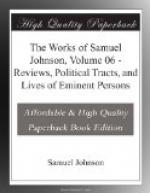The papers in the box were said to be eight letters, in French, some love-sonnets in French also, and a promise of marriage by the queen to Bothwell.
To the reality of these letters our author makes some considerable objections, from the nature of things; but, as such arguments do not always convince, we will pass to the evidence of facts.
On June 15, 1567, the queen delivered herself to Morton, and his party, who imprisoned her.
June 20, 1567, Dalgleish was seized, and, six days after, was examined by Morton; his examination is still extant, and there is no mention of this fatal box.
Dec. 4, 1567, Murray’s secret council published an act, in which is the first mention of these letters, and in which they are said to be written and subscrivit with her awin hand. Ten days after, Murray’s first parliament met, and passed an act, in which they mention previe letters written halelie [wholly] with her awin hand. The difference between written and subscribed, and wholly written, gives the author just reason to suspect, first, a forgery, and then a variation of the forgery. It is, indeed, very remarkable, that the first account asserts more than the second, though the second contains all the truth; for the letters, whether written by the queen or not, were not subscribed. Had the second account differed from the first only by something added, the first might have contained truth, though not all the truth; but as the second corrects the first by diminution, the first cannot be cleared from falsehood.
In October, 1568, these letters were shown at York to Elisabeth’s commissioners, by the agents of Murray, but not in their publick character, as commissioners, but by way of private information, and were not, therefore, exposed to Mary’s commissioners. Mary, however, hearing that some letters were intended to be produced against her, directed her commissioners to require them for her inspection, and, in the mean time, to declare them false and feigned, forged and invented, observing, that there were many that could counterfeit her hand.
To counterfeit a name is easy, to counterfeit a hand, through eight letters very difficult. But it does not appear that the letters were ever shown to those who would desire to detect them; and, to the English commissioners, a rude and remote imitation might be sufficient, since they were not shown as judicial proofs; and why they were not shown as proofs, no other reason can be given, than they must have then been examined, and that examination would have detected the forgery.
These letters, thus timorously and suspiciously communicated, were all the evidence against Mary; for the servants of Bothwell, executed for the murder of the king, acquitted the queen, at the hour of death. These letters were so necessary to Murray, that he alleges them, as the reason of the queen’s imprisonment, though he imprisoned her on the 16th, and pretended not to have intercepted the letters before the 20th of June.




